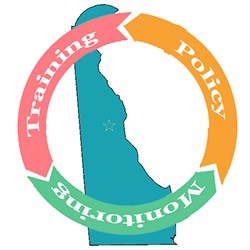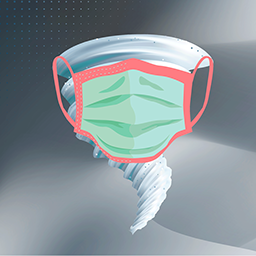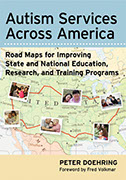Train & Hope??
![]() Training is necessary but often insufficient to ensure adoption of new practices.
Training is necessary but often insufficient to ensure adoption of new practices.
White elephant
![]() Create effective, sustainable programs before sinking money into a new building.
Create effective, sustainable programs before sinking money into a new building.
Implement, baby, implement
![]() Is traditional autism research becoming a bridge to nowhere?
Is traditional autism research becoming a bridge to nowhere?
Research to guide services
AutismSpectrumNewsNot all research is equally relevant to those focused on providing services.
A Network on Excellence
 Can statewide training increase expertise and capacity, and bridge gaps?
Can statewide training increase expertise and capacity, and bridge gaps?
A Bus to Betsy's
 The nominee to lead special education in the US could send it back to the Stone Age.
The nominee to lead special education in the US could send it back to the Stone Age.
The Business of innovation
 New services are shaped not by research but by available funds, staff, and expertise.
New services are shaped not by research but by available funds, staff, and expertise.
Margot votes! Will others?
 Learn how people like Margot exercise their right to vote in the 11 states that allow it .
Learn how people like Margot exercise their right to vote in the 11 states that allow it .
CoVid's silver lining
 Insights into the isolation and costs of disability might finally spur policy changes.
Insights into the isolation and costs of disability might finally spur policy changes.
A State of Synchro
The magic of teaching someone like Margot to ski mobilizes a remarkable army.
A Drop in the Bucket
New data suggests ASD research has little impact on improving identification.
The business of innovation in ASD services
There is no voyage of discovery without expert sailors, a solid ship, and a willing crew
December 13, 2016; Expanded February 16, 2017
 We might like to believe that the development of new ASD research and new services is akin to the voyages of the heroic Western European explorers of the 15th century. A visionary leader is driven to discovery, even if it means crossing unknown waters where there might be monsters. And the discovery of a new world fundamentally changes how we see ourselves and our future. A simple and compelling story of the apparently inevitable march of knowledge.
We might like to believe that the development of new ASD research and new services is akin to the voyages of the heroic Western European explorers of the 15th century. A visionary leader is driven to discovery, even if it means crossing unknown waters where there might be monsters. And the discovery of a new world fundamentally changes how we see ourselves and our future. A simple and compelling story of the apparently inevitable march of knowledge.
But I love to pull back the curtain and look at the mess behind the myths of history and science. Whether we are talking about Western European Age of Discover, or the modern day Age of ASD, the I am much more fascinated by the almost accidental convergence of many small technological advances in a particular time and place that suddenly made the impossible possible. And I have begun to appreciate how many voyages of geographical and scientific discovery were driven by other social, political, and economic forces (and often interwoven with individual stories of intrigue and sex). The best explorers were often also consummate politicians and businessmen, first and foremost in search of a ship and a crew.
On a trip to Portugal, I saw how scientific knowledge, technical skill, political intrigue, and the pursuit of wealth converged in an explosion of geographic discovery in Western Europe. In effect, the future course of Europe was forever transformed by one of its smallest kingdoms over just 3 generations. In the 70 years after the discovery of the Azores in 1427, the Portuguese voyaged to Senegal and Sierre Leone, rounded the Cape of Good Hope to reach India, and sailed west to discover Brazil and Newfoundland. This was a much more complicated - but much more interesting - version of history than the romantic version I was fed in high school that centered on the exploits of individual explorers like Cabral and Vasco da Gama. It grew from a maritime industry launched by Henry the Navigator, resulted in better ships like the caravels, and better astronomical charts based on careful observations of the stars. And it gained new impetus from political developments with religious implications, like the fall of Constantinople to the Ottomans that disrupted traditional trade routes to the east and created a new urgency to proselytize pagans. Indeed, the story of these other converging social, political, and economic forces offers striking parallels for some of the breakthroughs we strive in today's Age of ASD.
We try to tell equally simple and compelling stories about scientific discoveries that can lead to improvements in services for people with ASD. We would like to believe that research evolves solely through competition between the best ideas advanced by scientific leaders (survival of the smartest?), that services drive treatment breakthroughs to those most affected by ASD (survival of the neediest?), and that policies evolve to ensure sure that everyone is supported (survival of the most?). This oversimplified account overlooks the role that other social, political, and economic forces might play in the evolution of innovations in ASD research and services. Our failure to anticipate and respond to these other forces has created gaps in implementation are so persistent and pervasive, as if we might have ships and crews but few captains and still fewer maps.
 In this piece, I pay close attention to the business behind innovations in the development of new ASD services by focusing on three often overlooked resources most critical to this business - expertise, funding, and core staff. In sum, ASD service innovation is shaped less by research and more by available expertise, funding, and core staff. As a result, established services may grow rapidly at the expense of emerging needs. Shedding light on this business reveals how the same forces that stoke the fire of deeper knowledge and more comprehensive programs in more established areas of services may also smother the spark of potential breakthroughs. In a later piece, I will apply these same principles to the apparent growth of scientific knowledge surrounding ASD, to understand how the current academic-research industry unintentionally stifles innovative ideas.
In this piece, I pay close attention to the business behind innovations in the development of new ASD services by focusing on three often overlooked resources most critical to this business - expertise, funding, and core staff. In sum, ASD service innovation is shaped less by research and more by available expertise, funding, and core staff. As a result, established services may grow rapidly at the expense of emerging needs. Shedding light on this business reveals how the same forces that stoke the fire of deeper knowledge and more comprehensive programs in more established areas of services may also smother the spark of potential breakthroughs. In a later piece, I will apply these same principles to the apparent growth of scientific knowledge surrounding ASD, to understand how the current academic-research industry unintentionally stifles innovative ideas.
To illustrate the business of developing new services, I will contrast two examples of programs. The first is a new college-based transition program that equally emphasizes lifelong learning AND employment though community-based partnerships, like that described in detailed in the Transition Pathways Proposal. The second type of program can be found across the USA, at places like the Children's Hospital of Philadelphia: an integrated research assessment clinic created by braiding a university-based program of ASD research with a specialized hospital diagnostic program. For the sake of this piece, we will imagine that the clinic focuses on children between 2 and 5 years of age who have yet to be diagnosed. The researchers have hypothesized that a new technique for assessing precursors to social engagement might help to identify what kinds of children may respond best to certain classes of treatment. The researchers braid the traditional diagnostic assessment offered by the hospital clinic with other measures included in the research protocol to result in a more comprehensive assessment for those who consent to participate in the research study. They also offer a follow-up appointment after one year to check on the child's progress.
Who pioneers new approaches?
What kinds of professionals can develop innovative services?
To develop innovative services, you need more that science. You need experience in delivering services, leading programs of services, and developing new programs of services. If the innovative services are to be community based, then this experience experience must also be community-based. And if these services are to draw from specific research, then some experience in translating research findings into services will also be needed.
The need for this kind of training and experience seems obvious, yet I have spoken with many different people who seem to misunderstand what is needed. This includes advocates and philanthropists who assume that everyone is equally trained and experienced in research and in service delivery. Even more worrisome are researchers who underestimate the value of experience in delivering or leading services, especially those that are community-based. I have seen too many researchers try to meet this need by relying on enterprising but inexperienced early career clinicians.
So here is a quick primer.
- Many - perhaps most - ASD researchers have never been trained to deliver services (e.g., as a physician, teacher, psychologist, nurse, and so on). Even researchers who study services like diagnosis and treatment very intensively may not be clinically trained.
- Everyone trained to provide a service studies research as part of their initial training, but few full-time service-providers are trained to the point where they can independently conduct research that garners grants and produces publications.
- A minority of researchers and service providers are trained to do both - I will call them clinician-researchers. Here too the type of experience is highly variable and often quite specific. For example, some clinician-researchers do not seek experience in delivering services once they graduate. Some clinician-researchers who focus on research may continue to provide services but these are often restricted to a specific niche: for example, a specific service (like diagnosis), for a specific population (like young children), often in a specific setting (like a hospital clinic).
- Very few clinician-researchers have experience developing community-based programs of services, and fewer still have experience leading a community-based program of services.
Gaps in training and experience have many cascading effects on service innovation, only two of which I will address here. First, many projects striving to create innovative services start off by addressing a specific niche - a specific treatment for a specific type of person in a specific type of setting. Without a broader base of training or experience, proponents overgeneralize the results they might obtain, or underestimate the resources needed, when they try to step outside of that niche. For example, a clinician-researcher who has come to rely on a comprehensive diagnostic protocol in a specialized hospital clinic for young children may be surprised by the reluctance of community-based providers to apply similar protocols to diagnosing all of their patients in the spectrum in their practice. This lack of community-based experience may be one reason why so many researchers invest in a Train and Hope approach, or move too quickly to blame implementation failures on what they construe as the shortsightedness of community-based clinicians.
Second, few individuals have all of the requisite background in services and leadership, and so innovative services will almost always require the assembly of a team with complementary skills and experience. But there is always the risk of the built in bias from each team member's perspective: the researcher will always place the greatest faith in research, the clinician will value services the most, and both will under-estimate the challenges of community-based practice if they lack this experience. Under these circumstances, respectful partnerships, clear communication, and a longer runway for the project launch become even more important. This is on reason why researchers who rely on inexperienced clinicians will never fully exploit the opportunities for true innovation.
Expertise that integrates services and research grows rapidly in established areas, but glacially elsewhere
New and innovative programs of services depend entirely on the availability of new expertise. By expertise, I mean the skills and experience needed to evaluate available research supporting a specific intervention, to outline a new variant of treatment or service, to supervise supporting staff, to provide training in more specialized procedures, and to mobilize resources through grants or business plans.
How is expertise in ASD services acquired? A degree or license might confer competence in a basic set of research or clinical methods, but it rarely confers the expertise needed to innovate. This level of expertise is typically derived from specialized post-graduate experience above and beyond that required for any professional license. This also includes mentoring from someone with established expertise in a strongly related area, and who has already successfully launched their own new program of clinical services or research. Community-based programs can draw on a variety of strategies to expand this expertise. We can measure the development of expertise in generations: a new generation is born when people enroll in graduate training, matures through specialized post-graduate experience and mentorship, transitions out of adolescence through the experience of successfully launching new clinical research or services, and enters full adulthood with the professional maturity and experience to mentor a new clinician or researcher.
Framing the development of expertise in the trajectory of a person's career has several important implications. First, the timeline for each new generation of expertise varies from profession to profession, and lengthens for those with doctoral-level training. For example, if we generously assume that the transition into adolescence into full adulthood described previously is 5 years, then the timeline from birth to full adulthood can vary from 8 years for a master-level clinician (like a teacher, BCBA, or SLP) to 11 years for a psychologist or researcher to 14 years or longer for a specialized medical doctor.
This timeline is important: a new educator, clinician, or researcher must invest their formative professional years into a specific area to truly establish expertise. This also means that a decision by an emerging or established expert to re-tool - to develop a different kind of expertise - probably requires a detour of at least 3-5 years, some collaborative relationship with a more experienced partner, and a willingness to take risks.
Second, the framework underscores how the maturation of clinicians and researchers into emerging and then true experts often depends on the availability of established experts. Of course, some emerging researchers, educators, and clinicians can truly break new ground, but this likely requires an even longer trajectory and carries even greater risk. This means that that expertise is more likely to emerge in areas of established inquiry. In the case of our integrated research assessment clinic, for example, decades of research into the assessment and diagnosis of ASD has created very fertile ground for the new expertise needed. The techniques for assessing precursors to social engagement is likely an extension of existing measures and an existing program of research. For our college transition program, there is almost no research on effective interventions for young adults, and likewise little to fuel the growth of the new expertise needed.
Third, positions that naturally support mentoring of emerging experts turn out to be relatively rare outside of specialized, university- or hospital-based ASD programs. Most school- and community-based programs are simply too small to create the critical mass of professionals needed for one person to emerge as an expert, to develop and deliver the kind of specialized post-graduate training needed, and to assume a supervisory relationship with a new clinician or educator. As a result, the traditional trajectory for acquiring expertise - through specialized, university- or hospital-based ASD programs - is much less likely to have included meaningful experience in less specialized, community-based settings (Doehring, 2013). For example, there are countless, specialized diagnostic clinics across the country that integrate research and post-graduate training needed for our new assessment clinic. In contrast, there are very few adult transition programs that vigorously promote employment and almost none that integrate research and post-graduate training that involved community-based partnerships...and so very few opportunities to grow expertise.
Expertise is therefore much more likely to be found - and new programs are much more likely to grow - in the established areas of services to be found in specialized university- and hospital-based ASD programs that do not require community-based partnerships. In these programs, new expertise can emerge with each new generation, or about every 10 years for doctoral-level clinicians and researchers. But this also means that expertise in truly innovative services, especially those involving community-based partners, will take longer to develop, if it develops at all. So expertise grows geometrically in areas of established inquiry or services in traditionally specialized settings, but grows glacially elsewhere.
Who will pay for the ship?
Available funding, not new research findings, determines which ASD services will expand
Look back over the last three decades and consider, which ASD services expanded most rapidly across the country and when? Did this coincide with new discoveries about the causes or core characteristics of ASD, or breakthroughs in treatment? Or was it more strongly influenced by new funding sources and strategies? Without question, it was the latter. And to understand these funding sources and strategies, we need to distinguish the support for the services provided separately from the support needed to design and launch a new program of services.
The funding needed to deliver services
The rise and expansion of early and intensive behavioral intervention or EIBI is a case in point that illustrates the hidden hand of funding in the expansion of successful services (Doehring, 2013). Certainly, the discoveries initially reported in the scientific literature were pivotal to the initial excitement surrounding EIBI. But I believe that a critical factor in EIBI's rapid rise was also the identification of ready funding sources: at first, willing parents able to pay privately, and later, unwilling public schools compelled to pay through the legal actions taken by frustrated parents. EIBI's momentum was unchecked by other scientific questions and findings that cast doubt on the gains originally reported: where there is funding, services will follow, heedless of the science. After a time, the costs associated with providing a specialized service like EIBI stabilized, allowing program developers to create business or research plans with more confidence. Science played a unique role in justifying more intensive, specialized, and therefore more costly services: in lawsuit after lawsuit, advocates drew directly from the research to require at least forty hours per week of services over at least two years.
Consider our research-assessment clinic. The fact that most costs have largely been established, and many of these are already reimbursed through insurance, greatly simplifies the task of launching an integrated research assessment clinic. Insurers already cover specific activities involved in the clinical assessment, while funding agencies recognize the need for the more rigorous evaluations required for research. The additional assessments needed for the specific research question may only add an hour or two to the protocol. In most cases, program leaders can control costs by drawing on the best cheap (or sometimes free) labor available; smart undergraduate or graduate students seeking to carve their own career path. And because the clinic provides very specific services over a very specific number of visits, the total cost per client can be precisely calculated. As a result, the total costs associated with a core activity of our integrated research clinic can be calculated and justified, and can draw readily from established funding sources.
Contrast this with our college transition program. There is almost no research on effective interventions for young adults, and therefore no information to project total costs. What kind of intervention is needed, and how much of it? Who is to deliver it? And a much greater commitment is required to support the cost of two years of full-time comprehensive services than a diagnostic assessment likely requiring no more than 5-6 two hour visits to a clinic. A proposal can leverage some free or cheap support from undergraduate volunteers (like peer mentors), but this will always by limited given the nature of the program. Moreover, funding sources for traditional services are often inadequate, and split between different agencies that may have no history of coordination. One of the goals of the Transition Pathways Proposal was to demonstrate the use of a collective impact model to braid funding and resources across different agencies. But in this case, the significantly greater cost of services, the inability to project the total costs needed to achieve a specific outcome, and the overall lack of funding creates tremendous barriers to service innovation.
The funding needed to develop and launch services
A lesson often learned too late is that it is easy to underestimate the cost of program development, including the time to design, launch, and adjust a program model, as well as the initial and ongoing training needs. I drew on this lesson when defining the investment in program development required for Transition Pathways. Stated differently, service providers do not bill clients separately for the costs of program development. This leaves them with two choices: they can fold these costs into the fees charged for direct services that they already provide, or they can seek special funding from within or from outside of their organization to specifically support the launch phase. These choices create different challenges for more established versus more innovative services.
Folding program development costs into existing fees can work, but only when a fee-based service is already being provided in a market that is still emerging. Once a service has been established - that is, its costs and its outcomes are known - there is often downward pressure to decrease costs per client. As a service becomes offered by more and more providers, the downward pressure on fees invariably results in cuts to program development to remain competitive. To the bean counters, this makes sense: there is no longer the same need to develop training materials, the cost of bringing new staff onboard has been established, and so on. Agencies often fail to develop a long-term plan to sequester the greater profits possible when services are emerging, and so struggle to find the funds to re-tool services later, when a saturated market now yields thin margins.
Finding funds to launch a truly innovative service is even more challenging, and is almost impossible for the vast majority of community-based programs. A large and forward-thinking agency that provides many different kinds of services at different stages of maturity may develop the funding flexibility needed, including the ability to re-allocate experts and leaders to support development. Otherwise, program developers have little choice but to turn to grants or philanthropy. Remarkably, I cannot think of any ongoing, federal grant program that offers the support needed to pilot truly innovative, community-based programs of ASD services at the level required. In any case, access to research grants presupposes a relationship with a university, which a community-based program might find difficult to establish. To date, even federal funding to university-affiliated programs has been restricted to very small pilot projects, in areas that are specific and well-established.
This leaves us to make the case for the funding of more innovative programs of services to generous and visionary philanthropists. But even here, the risks are significant. For example, the $3.5 million commitment to Transition Pathways was the fruit of a long-standing relationship between a university and a philanthropist. Failure to deliver the promised outcomes could cost the university untold millions in potential future gifts.
In the case of our integrated research assessment clinic, for example, the time needed to develop the new procedure for assessing precursors to social engagement is built into the salary support for the lead researcher. The very nature of research presupposes that researchers set aside significant time and effort to develop new ideas. In addition, the costs for developing and delivering these services can be readily calculated. In many cases, emerging experts would already have experience helping to write, review, or implement grants for similar programs. Most researchers seek multiple grants with overlapping questions that together can support the time needed to develop the next grant proposal. To the extent that the clinic can build on protocols already established by others, the overall resources needed for developing a new clinic model may be limited. And many university programs now include specific personnel to help develop proposals for funders and philanthropists, and may in fact have already established trusting relationships with them.
Contrast this with our college transition program. If the program is not developed by a university-based researcher, a community-based leader may have limited effort allocated to program development built into their job description, and no supports within their organization to support grant writing or project development. The college transition program also requires additional, systematic planning and collaboration across the different agencies involved. Most settings will simply not know where to start. Uncertainty about the total resources required for a more innovative program may lead a developer to just cobble something together from pre-existing packages with known costs (like Project SEARCH), and then try to pass this off as innovation.
Who will hoist the sails and swab the decks?
Services cannot expand without a reliable pipeline of trained staff
The bulk of the day-to-day work done directly with the clients involves someone other than the expert described above. What does that work entail? Which professional and which non-professional staff are needed? How much training do you need to be able to do it? Is there a pool of people already trained - or at least eager to be trained?
Some of the answers can be found in lessons described elsewhere, like the need for programs of services to create a pipeline of professional staff. For some programs, this must also include a plan to build and maintain the team of non-professional aides who may provide the bulk of direct service. The answers to these questions and others will help to establish your program's overall cost, above and beyond the day-to-day cost of operations once the program is established. For example, how long is your initial recruitment and launch phase? This is important because there is no revenue or research or until your first client walks through the door. Other answers about the availability of staff will determine how readily you might replicate your program in the future.
Consider the example of our integrated research assessment clinic. Many of the assessments used are delivered by specialists who have probably already received training and supervision in some of these instruments. In fact, these specialists are likely to have already assessed children with ASD as part of their training. Most university-affiliated hospital settings have departments to support these specialists, and a well-developed pipeline to recruit new staff (like internships for students completing their training). Recruiting and training the staff needed to support a more comprehensive diagnostic clinic is relatively straightforward
Contrast this with our college transition program. It relies on a mix of non-professionals (like school-based aides and volunteer peer mentors), and professionals from different backgrounds and agencies (like special education teachers based in public schools, job coaches based in vocational rehabilitation agencies, and university-based counselors based in student support services). None of these non-professionals or professionals is likely to have had any training in supporting students on the autism spectrum in a college transition program. And they may have had little training in developmental disabilities. In the case of job coaches, for example, I know of no state that requires training or experience in working with people with disabilities, let alone people on the spectrum. Instead, a job coach may only need a bachelors degree in a field related to human services. This creates significant barriers for start up, expansion, and replication because of the extensive initial training and ongoing supervision needed by core staff.
Gaps in expertise, funding, and core staff: A perfect storm to sink innovation
Any one of the barriers described above - the lack of expertise, funding, and core staff - creates headwinds that could easily sink a new venture. In fact, the details provided elsewhere on this site about the considerations in designing the Transition Pathways program are intended to help future program developers anticipate these headwinds. But when all of these converge, they can create a perfect storm.
And this does not include other important factors. I discuss elsewhere the tendency of program developers to over-estimate the availability of experienced leaders able to navigate the shoals between research and community-based programs. Many may aspire to leadership, but how many are truly qualified? A university-based clinician or educator who had never led - or even provided - community-based services? A researcher who is not trained to provide services? A community-based leader without specific clinical or research expertise?
These and other headwinds may have relatively less of an impact on the launch of our integrated research clinic, because it relies on an established model applied within a single specialized setting. But they will surely surely drive a more innovative program of services off course, or sink it entirely. The most promising territory for innovation in ASD services will remain undiscovered as voyagers steer clear of the wreckage of unsuccessful journeys and stick to more established routes.
Related Content
On this site
Train & Hope??
![]() Training is necessary but often insufficient to ensure adoption of new practices.
Training is necessary but often insufficient to ensure adoption of new practices.
White elephant
![]() Create effective, sustainable programs before sinking money into a new building.
Create effective, sustainable programs before sinking money into a new building.
Implement, baby, implement
![]() Is traditional autism research becoming a bridge to nowhere?
Is traditional autism research becoming a bridge to nowhere?
Research to guide services
AutismSpectrumNewsNot all research is equally relevant to those focused on providing services.
A Network on Excellence
 Can statewide training increase expertise and capacity, and bridge gaps?
Can statewide training increase expertise and capacity, and bridge gaps?
A Bus to Betsy's
 The nominee to lead special education in the US could send it back to the Stone Age.
The nominee to lead special education in the US could send it back to the Stone Age.
The Business of innovation
 New services are shaped not by research but by available funds, staff, and expertise.
New services are shaped not by research but by available funds, staff, and expertise.
Margot votes! Will others?
 Learn how people like Margot exercise their right to vote in the 11 states that allow it .
Learn how people like Margot exercise their right to vote in the 11 states that allow it .
CoVid's silver lining
 Insights into the isolation and costs of disability might finally spur policy changes.
Insights into the isolation and costs of disability might finally spur policy changes.
A State of Synchro
The magic of teaching someone like Margot to ski mobilizes a remarkable army.
A Drop in the Bucket
New data suggests ASD research has little impact on improving identification.
X
My Related Publications
Guideposts
![]() Simple Steps Create a pipeline of core professionals, and assemble the resources needed to build and sustain their expertise
Simple Steps Create a pipeline of core professionals, and assemble the resources needed to build and sustain their expertise
![]() Simple Steps Consider the resources required to recruit and train non-professional staff when planning to develop or expand services.
Simple Steps Consider the resources required to recruit and train non-professional staff when planning to develop or expand services.
![]() Other Lessons There is no natural pipeline of leaders trained and experienced in undertaking comprehensive program development
Other Lessons There is no natural pipeline of leaders trained and experienced in undertaking comprehensive program development
![]() Other Lessons Turning research into com-munity practice requires collaboration across researchers, practitioners, and agencies
Other Lessons Turning research into com-munity practice requires collaboration across researchers, practitioners, and agencies
![]() Other Lessons Improving and expanding services in a coordinated and sustainable way requires planning, expertise, and leadership
Other Lessons Improving and expanding services in a coordinated and sustainable way requires planning, expertise, and leadership
![]() Other Lessons To expand competence or to increase capacity, you must cultivate new experts recruited within the organization
Other Lessons To expand competence or to increase capacity, you must cultivate new experts recruited within the organization
![]() Other Lessons Many people promoting new practices focus on programs of training, ignoring other needed changes in policy and services.
Other Lessons Many people promoting new practices focus on programs of training, ignoring other needed changes in policy and services.
